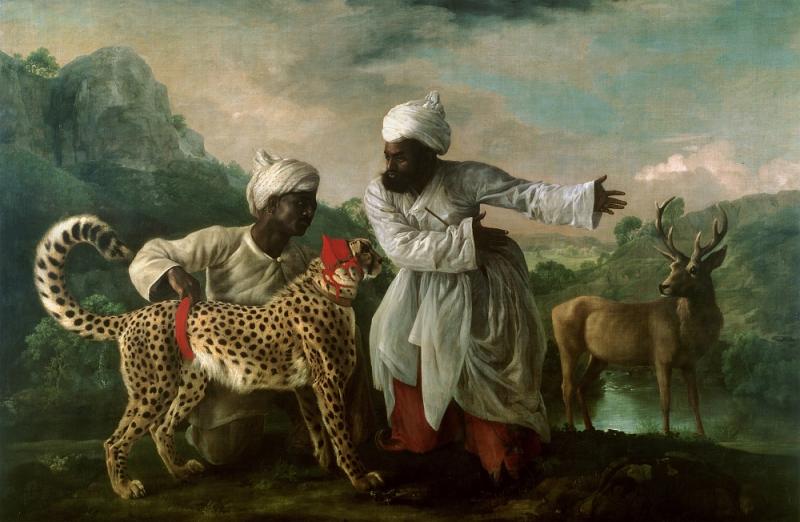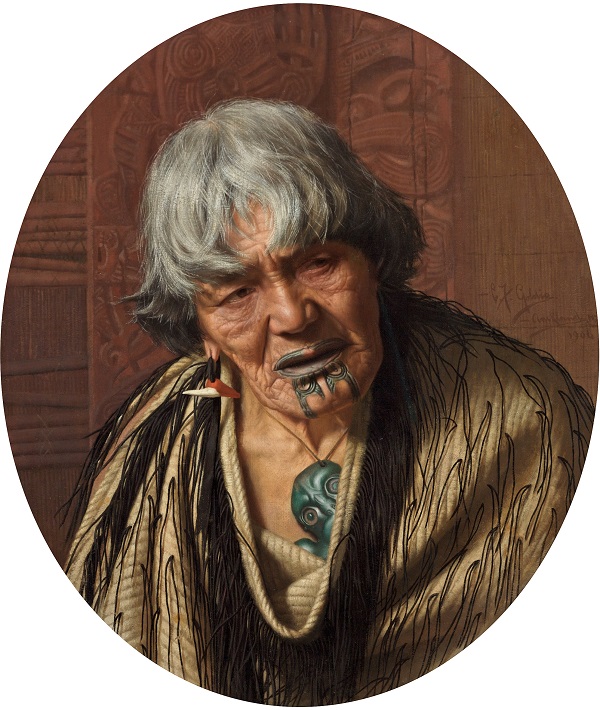Artist and Empire, Tate Britain | reviews, news & interviews
Artist and Empire, Tate Britain
Artist and Empire, Tate Britain
An ambitious survey that fails to do justice to a vast and complex subject

There are some wonderful things in this exhibition, and that’s no surprise: the British Empire endured for over 500 years and at its peak extended across a quarter of the world’s land mass. Preparing an exhibition of corresponding reach must have involved considering a vast range of objects, but choosing well is another matter entirely.
So it is that the first room, devoted to maps and map-making, feels like a statement of intent, getting in its condemnation of the British in advance of the many paintings we are about to see that glorify them. Crucial as they are to the business of empire-building, these maps are also raw representations of conquest, serving not only a practical purpose but an ideological one. It was through maps that indigenous place names were brutally and formally erased, and they provided a cheap and easily distributed means of hammering home the might of the British Empire across the globe, in schools, public buildings, homes and offices. Maps can be beautiful things, but here they act rather like a visual disclaimer for what is to follow.
 You can see exactly why such a caveat might have seemed necessary the moment you step foot in the next room, which bursts with glorious, exotic riches pillaged from far-flung lands. Centuries on, it is all still rather close to the bone, for in this dazzling array of botanical drawings and collected drawings is the same spirit that has shaped so many of our museum collections. Stubbs’ A Cheetah and a Stag and Two Indian Attendants, c. 1764, on loan from Manchester Art Gallery, is the crowning glory, and encapsulates the sense of wonder and excitement of the British at the expansion of the Empire (main picture).
You can see exactly why such a caveat might have seemed necessary the moment you step foot in the next room, which bursts with glorious, exotic riches pillaged from far-flung lands. Centuries on, it is all still rather close to the bone, for in this dazzling array of botanical drawings and collected drawings is the same spirit that has shaped so many of our museum collections. Stubbs’ A Cheetah and a Stag and Two Indian Attendants, c. 1764, on loan from Manchester Art Gallery, is the crowning glory, and encapsulates the sense of wonder and excitement of the British at the expansion of the Empire (main picture).
One of the most impressive, but simultaneously shocking rooms deals with history paintings made to commemorate and glorify British conquests overseas. For the most part these paintings serve to add a veneer of British decency to episodes of barbarity, and in Robert Home’s The Reception of the Mysorean Hostage Princes by Marquis Cornwallis, 26 February 1792, c.1793, the British soldiers taking two little boys prisoner appear as amiable as kindly uncles. In shocking contrast is Edward Armitage’s vast painting Retribution, 1858, in which a fearsome Britannia slays a Bengal tiger. It was meant to hang in Leeds Town Hall, intended to stir up the vengeful anger of the British in response to the Cawnpore Massacre of 1857, in which over 100 British women and children were murdered.
As the Empire matured, relations between colonist and colonised inevitably became more complex, and the second half of the exhibition struggles in vain to address and represent the different encounters and narratives of Britain’s colonial past. While the first rooms have a coherence that comes from presenting art from within the same western tradition, the multiple and varied cultures of the colonies can only be inadequately represented. At its height, the British Empire was so vast and the people within it so diverse that the attempt could hardly be anything but tokenistic.
 Nevertheless, some fascinating examples of the mingling of western and indigenous artistic traditions emerge, the carved figure of Queen Victoria made by a Yoruba artist in Nigeria, combining traditional wood-carving techniques with western portraiture (Pictured above right), while the European taste for romanticised portraiture found new, exotic subjects in the colonies (Pictured left: Charles Frederick Goldie, Harata Rewiri Tarapata: A Maori Chieftainess, 1906).
Nevertheless, some fascinating examples of the mingling of western and indigenous artistic traditions emerge, the carved figure of Queen Victoria made by a Yoruba artist in Nigeria, combining traditional wood-carving techniques with western portraiture (Pictured above right), while the European taste for romanticised portraiture found new, exotic subjects in the colonies (Pictured left: Charles Frederick Goldie, Harata Rewiri Tarapata: A Maori Chieftainess, 1906).
Like almost every topic addressed here, the attempt to summarise the impact of non-western art on European artists in the 20th century really merits its own exhibition, while the examination of the legacies of empire would feel incredibly truncated were one actually capable of looking at anything more. This is an ambitious show that has overstretched itself; by trying to fairly represent every aspect of this long and complicated episode in world history, the whole endeavour lacks the gravitas it deserves.
rating
Explore topics
Share this article
The future of Arts Journalism
You can stop theartsdesk.com closing!
We urgently need financing to survive. Our fundraising drive has thus far raised £49,000 but we need to reach £100,000 or we will be forced to close. Please contribute here: https://gofund.me/c3f6033d
And if you can forward this information to anyone who might assist, we’d be grateful.

Subscribe to theartsdesk.com
Thank you for continuing to read our work on theartsdesk.com. For unlimited access to every article in its entirety, including our archive of more than 15,000 pieces, we're asking for £5 per month or £40 per year. We feel it's a very good deal, and hope you do too.
To take a subscription now simply click here.
And if you're looking for that extra gift for a friend or family member, why not treat them to a theartsdesk.com gift subscription?
more Visual arts
 'We are bowled over!' Thank you for your messages of love and support
Much-appreciated words of commendation from readers and the cultural community
'We are bowled over!' Thank you for your messages of love and support
Much-appreciated words of commendation from readers and the cultural community
 Folkestone Triennial 2025 - landscape, seascape, art lovers' escape
Locally rooted festival brings home many but not all global concerns
Folkestone Triennial 2025 - landscape, seascape, art lovers' escape
Locally rooted festival brings home many but not all global concerns
 Sir Brian Clarke (1953-2025) - a personal tribute
Remembering an artist with a gift for the transcendent
Sir Brian Clarke (1953-2025) - a personal tribute
Remembering an artist with a gift for the transcendent
 Emily Kam Kngwarray, Tate Modern review - glimpses of another world
Pictures that are an affirmation of belonging
Emily Kam Kngwarray, Tate Modern review - glimpses of another world
Pictures that are an affirmation of belonging
 Kiefer / Van Gogh, Royal Academy review - a pairing of opposites
Small scale intensity meets large scale melodrama
Kiefer / Van Gogh, Royal Academy review - a pairing of opposites
Small scale intensity meets large scale melodrama
 Jenny Saville: The Anatomy of Painting, National Portrait Gallery review - a protégé losing her way
A brilliant painter in search of a worthwhile subject
Jenny Saville: The Anatomy of Painting, National Portrait Gallery review - a protégé losing her way
A brilliant painter in search of a worthwhile subject
 Abstract Erotic, Courtauld Gallery review - sculpture that is sensuous, funny and subversive
Testing the boundaries of good taste, and winning
Abstract Erotic, Courtauld Gallery review - sculpture that is sensuous, funny and subversive
Testing the boundaries of good taste, and winning
 Edward Burra, Tate Britain review - watercolour made mainstream
Social satire with a nasty bite
Edward Burra, Tate Britain review - watercolour made mainstream
Social satire with a nasty bite
 Ithell Colquhoun, Tate Britain review - revelations of a weird and wonderful world
Emanations from the unconscious
Ithell Colquhoun, Tate Britain review - revelations of a weird and wonderful world
Emanations from the unconscious
 Rachel Jones: Gated Canyons, Dulwich Picture Gallery review - teeth with a real bite
Mouths have never looked so good
Rachel Jones: Gated Canyons, Dulwich Picture Gallery review - teeth with a real bite
Mouths have never looked so good
 Yoshitomo Nara, Hayward Gallery review - sickeningly cute kids
How to make millions out of kitsch
Yoshitomo Nara, Hayward Gallery review - sickeningly cute kids
How to make millions out of kitsch
 Hamad Butt: Apprehensions, Whitechapel Gallery review - cool, calm and potentially lethal
The YBA who didn’t have time to become a household name
Hamad Butt: Apprehensions, Whitechapel Gallery review - cool, calm and potentially lethal
The YBA who didn’t have time to become a household name

Add comment